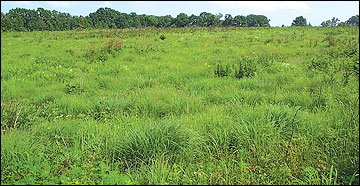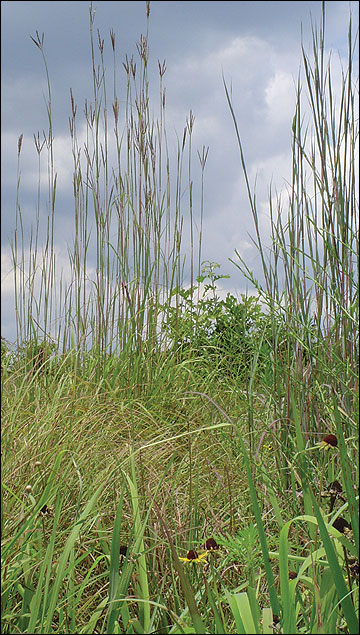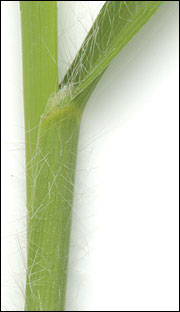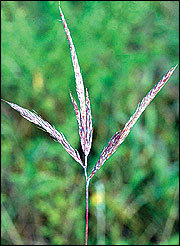Big bluestem
- Andropogon gerardii
- Turkeyfoot grass
Grass
Mature seed stalks of big bluestem are copper colored and often grow more than 5 feet tall.
Scott Sudkamp, Missouri Department of Conservation
 The clumpy growth of big bluestem allows room for other plants to exist and provides excellent habitat structure for nesting and roosting. Quail hens tend to nest at bases of grass clumps.
The clumpy growth of big bluestem allows room for other plants to exist and provides excellent habitat structure for nesting and roosting. Quail hens tend to nest at bases of grass clumps.
Robert N. Chapman, Missouri Department of Conservation
Description
Big bluestem is one of the taller native grasses in the Midwest, with seed stalks up to 9 feet tall, more commonly 4 to 5 feet. The seed head typically has three "prongs," giving it the appearance of a bird's foot. Leaves are commonly 1 to 3 feet long and may be either smooth or hairy. Plants take on a bluish-coppery hue upon dormancy in the fall.
Use by bobwhites
A dominant grass in prairies and native grass plantings, big bluestem grows in bunchy clumps that provide good habitat structure for nesting and brood rearing. Nests are made at the base of clumps from the previous year's growth. Burned stands often provide brooding habitat. Coveys frequently roost in fields containing big bluestem. Dense stands may provide escape cover and summer and winter thermal cover.
Big bluestem leaves contain little lignin, which causes them to droop after the growing season. Leaves and seed heads tend to flatten under ice or snow. Thus, pure stands of big bluestem provide poorer quality roosting or spring nesting cover than other native warm-season grasses. This problem can be alleviated by high-clipping or summer grazing that leaves a 10- to 15-inch stubble that is more resistant to flattening. It is best planted in mixtures with other native grasses.








